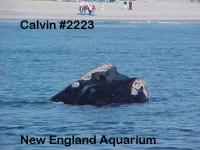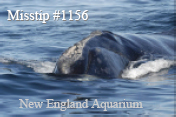
| GMWSRS Home Page | Ship
Strikes
| Entanglement
| Genetics
| Habitat
| Range Map
|
| Adoption Program | The
Whales | Links | Who has
been
adopted? | Adoption
Blog |
en
français |
| Right Whale Steward Program |

| GMWSRS Home Page | Ship
Strikes
| Entanglement
| Genetics
| Habitat
| Range Map
|
| Adoption Program | The
Whales | Links | Who has
been
adopted? | Adoption
Blog |
en
français |
| Right Whale Steward Program |
| HOW
TO SYMBOLICALLY ADOPT A NORTH ATLANTIC RIGHT WHALE
1. CHOOSE AN INDIVIDUAL WHALE, MOTHER/CALF PAIR OR FAMILY GROUP 2. FILL OUT THE ADOPTION FORM EITHER ONLINE OR PRINT OUT 3. SEND ADOPTION FORM BY: - PRINT
FORM & MAIL TO: - PRINT
FORM & FAX TO: -
CALL US: RATES: INDIVIDUALS - $40 MOTHER & CALF - $75 FAMILIES
-
WHAT IS INCLUDED IN THE ADOPTION PACKAGE? The adoption
certificate (suitable for framing) is sent in a portfolio and includes
the adoptee(s) name(s). Each has a photo of the individual
whale or matriarch of the family or photos of mother/calf pair. A
Family Tree is also
included when adopting a family. The portfolio will also include
information about the adoptive whale(s), North Atlantic right whales
and the research station. A postcard, magnet or bookmark will
also be included. CLASS
PROJECTS. Personalized individual business-size cards can
be
included for each student as well as a class certificate. An
age-appropriate activity will also be included. The Grand
Manan Whale & Seabird Research Station (GMWSRS) is a registered
charity in Canada incorporated in 1981 by its founder, the late Dr.
David
Gaskin.
We are dedicated to research and education which promote conservation of the marine environment. Our researchers study seabirds and marine mammals in the lower Bay of Fundy, Canada, and develop/deliver education and stewardship programs through a natural history museum, invited lectures, publications, specific projects, a web site and outdoor exhibits. Funding
for this web site is from the Government of Canada Habitat Stewardship
Program
for Species at Risk |
The
North Atlantic
Right Whale
With an estimated population size of about 400, the North Atlantic right whale is one of the world's most endangered large whale. Named by early whalers as the "right whale" to kill, this species was an easy target as it often stayed near the coast, was slow moving and floated when dead. Right whales travel from Florida to Iceland in the Western North Atlantic with a number of critical habitats recognized along the way including the calving area off Florida and Georgia, and feeding areas in Cape Cod Bay, Great South Channel, Gulf of Maine, the Bay of Fundy, and Scotian Shelf. Some right whales are also seen in more northerly locations such as the Gulf of St. Lawrence, Newfoundland, Greenland and Iceland. Little is known about the present day range in the Eastern North Atlantic, however, the Bay of Biscay was the location of the first commercial whaling beginning hundreds of years ago and right whales ranged north to Spitzbergen. Even though these whales have been protected from whaling since 1935, their population has shown no significant signs of recovery. It has been suggested that this may be due to a number of factors including:• Deaths caused by collisions with ships
Combined, these have
left the Right Whale in a very compromised position.• Deaths caused by fishing gear entanglements • Degradation & loss of habitat • Inbreeding due to low population numbers • Low reproductive rates  YOU CAN HELP! By symbolically adopting a North Atlantic right whale you can help us try to resolve these problems. Adopt an individual whale, a mother/calf pair, or a whole family for yourself, as a gift for family and friends, as a memoriam, or for your classroom or group. The tax deductible adoption fee will go towards costs for right whale research, conservation and education programs including:
Who can we adopt? We've added new whales! Individuals: Calvin #2223 Misstip #1156  
Gemini #1150 ; Calves
and their
Mothers: Drippy-nose (AKA
Sonnet) #1123, 1981 calf of Kleenex #1142 Bugs #1241, 1982
calf of Baldy
#1240 Resolution #3532,
2005 calf of Catspaw #1632
| The
Whales
Kleenex
#1142:
Kleenex was first seen with a calf in 1977. In 1991 she became a grandmother when her daughter Drippy-nose #1123 gave birth to her first calf. In 2001 she became a great-grandmother when her daughter's first calf gave birth. Today Kleenex has one of the biggest families with 7 calves, 5 grandcalves and 3 great-grandcalves.
(Drippy-Nose is also known as Sonnet in the North Atlantic Right Whale Catalogue) Baldy
#1240:
Baldy was first seen in 1974 near Long Island, New York, with her first known calf. In 1982, she gave birth to her second known calf, Bugs #1241. In 1989 she became a grandmother when Bugs gave birth to her first calf. Now Baldy has a total of 8 calves, 9 grandcalves and 1 great-grand calf Catspaw
#1632:
Catspaw is an adult female and was first seen in 1986. After a
long absence, she
reappeared in 2000 and had her first calf in 2002, #3232, followed by another in 2005. #3532, and a third in 2008.
In 2005, Catspaw was the first right whale mother to be seen giving
birth to her calf, Resolution. Wart #1140: Wart
was first identified in 1981 and is an adult female with a large family
of six calves, eight grand-calves and one great grand-calf. She
was recently entangled in fishing line. One of her sons,
Shackleton, travelled up the Delaware River in 1994 after separating
from Wart. He carries scars from being hit by a tug boat but did
eventually find his way back to the ocean. Misstip #1156:
Misstip is and
adult male and was
first seen in 1981. Misstip is missing both of his fluke tips. He has six calves and two
grand-calves. Two of his calves have the
same mother, Shenandoah #1266
and are full
siblings.
Misstip also has a male calf with Bugs
#1241. Gemini #1150:
Gemini is an
adult male and has three
calves and four grand-calves. His name comes from a pair of scars
on his back reminiscent of the constellation Gemini or the Twins.
Gemini is the father of Baldy's #1240 male calf #2140 . What do the
numbers mean?
The catalogue of recognizable individual North Atlantic right whales
was
started in 1980 by the New England Aquarium using techniques developed
by Roger Payne and his research group Payne's group discovered
that
each southern right whale had a recognizable pattern of rough patches
of
skin (callosities) on their heads. North Atlantic right whales
also
are uniquely marked. Why don't they have names instead of numbers? It is often easier to relate to a name than a number but in some ways it is easier to keep track of a system of numbers, particularly when dealing with computers and processing data. Think of all the different numbers you are known by - driver's licence, credit cards, birth certificate, etc. But some right whales do have names such as those here. The names usually refer to a marking or feature of the whale which makes it easier to remember the whale. In the next few years, all right whales will be given names. This naming process is being coordinated by the New England Aquarium. |
| GMWSRS Home Page | Ship
Strikes
| Entanglement
| Genetics
| Habitat
| Range Map
|
| Adoption Program | The
Whales | Links | Who has
been
adopted? | Adoption
Blog |
en
français |
| Right Whale Steward Program |
This
page maintained byACCESS
Powered
by SmartOrange.com Web
Hosting
Revised December 18th 2011